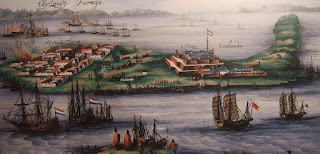Fort Zeelandia was built on a peninsula on the western edge of Tainan for protection from a direct attack by ships moving up to the port, itself.
This was during the time of the Dutch East India Company, a trading enterprise of The Netherlands . The fort took nearly 10 years to build from 1624 to1634.
Fresh water had to be transported to the very island-like peninsula, a problem that became magnified shortly after its construction.
For them to explode, the round shot balls were hollowed out and filled with gunpowder. An embedded fuse made for an explosion upon impact. To be technical, these were called artillery shells.
Any pictures not labeled are public domain and we are simply posting them to our blog.
| Map courtesy of Larry Barton
Kaohsiung on the southwest coast, Keelung on the north coast and Tainan were major ports of trade at this historical time.
|
| Photo courtesy of Taipics.com
A scale model of the fort shows not only its height, but also its thickness and complexity. Physically, this made it a virtually impregnable fortress.
|
 |
| Photo courtesy of Tom Jones
In 1958, this was one of the first sites that Tom and his friends had of Tainan.
|
 |
| Photo courtesy of Tom Jones
A circus happened to be in town during Tom's assignment in Tainan. It doesn't appear to be permanent.
|
| Photo courtesy of Tom Jones
Finally, this beautiful park with a large lake was worth a picture by Tom.
|
 |
| Photo courtesy of Tom Jones
Inside the fort, these 3 cannons make for a great tourist attraction.
|
| Photo courtesy of Taipics.com
Sure enough, here are the 3 cannons from another angle
|
 |
| Photo courtesy of Tom Jones
As we can see, this section of the fort was well preserved in 1958.
|
 |
| Photo courtesy of Tom Jones
Having said how well it was preserved, this picture indicates that the fort was not yet a great tourist attraction.
|
 |
The thickness of parts of Fort Zeelandia and its elevation are shown here. Many of the surrounding walls of the original fort still stand. |
 | |||
| Photo courtesy of Tom Jones
Looking from the side, this was what Tom saw of Fort Zeelandia in 1958.
The photo below is current.
|
 |
| Photo by Benjiho, the license holder
This is an official entrance today of the old Fort Zeelandia, now called Fort Anping.
|
A wall surrounds much of old Fort Zeelandia.
|
 |
East of Fort Anping, stand the remains of Chihkan Tower. This monument on the grounds of the old Fort Provincia depicts the Dutch surrender to China in 1662. |
Taken from its opposite side, the surrender monument gives more of an idea of the size of the entire attraction now called Chihkan Tower.
|
Today, this is what remains of Fort Provincia. It is now another beautiful tourist attraction in Tainan with an inviting entrance.
|
As is the case with many of Taiwan's formerly isolated structures, the old Fort Provintia takes up a block in downtown Tainan.
|




















